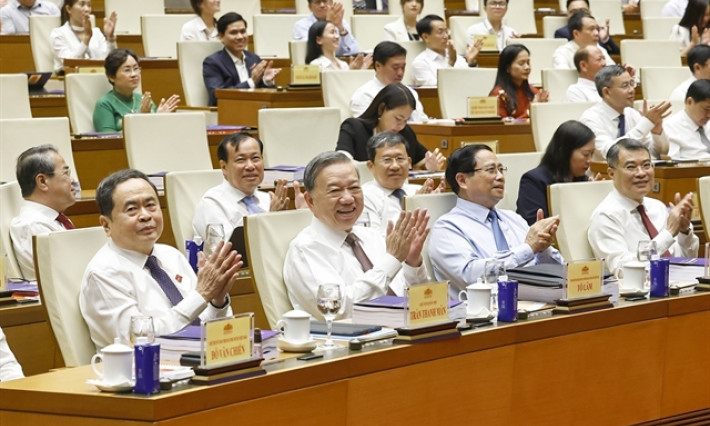Vietnam’s efforts to achieve growth target for 2025
Setting specific tasks is a creative approach to managing the economy, aimed at fostering dynamism and innovation so that localities can develop their own mechanisms. It also serves as a means to make each locality more accountable for their contributions to GDP growth.
On February 5, the government issued a resolution regarding growth targets for various sectors and localities to ensure the national GDP reaches 8% or higher in 2025. Specifically, all localities must achieve economic growth above 8%, with 18 out of 63 provinces and centrally governed cities targeting 10% or higher, and Bac Giang Province leading with a target of 13.6%.
Motivation and pressure
Previously, at a meeting to review the government’s performance in 2024 and outline tasks for 2025, General Secretary To Lam emphasised that 2025 holds special significance as a year of acceleration and breakthroughs, marking the country’s entry into a new era. As such, implementing a policy of assigning growth targets for localities is necessary to create dynamism and innovation, thus enabling them to develop their own mechanisms, policies and solutions to achieve double-digit growth and contribute to national economic growth.
According to Associate Professor Nguyen Thuong Lang, senior lecturer at the National Economics University, assigning growth targets to each locality essentially means increased decentralisation and delegation of authority to localities, allowing local potential to be maximised for growth from the local level. This serves as both motivation and pressure, requiring localities to fundamentally reform their operations, increase policy experimentation, implement goal-based management, use indicators to evaluate success, and be transparent about development models to avoid pursuing quantity at the expense of quality. “Some localities have actually achieved double-digit growth, providing a model for other localities to learn from,” noted Associate Professor Nguyen Thuong Lang.
Sharing this perspective, Associate Professor Dinh Trong Thinh, senior lecturer at the Finance Academy, argued that Vietnam’s growth has historically been considered below its potential, mainly because localities haven’t grown proportionately, remaining stagnant and lacking initiation in mobilising resources for growth. Even when growth occurs, it falls short of expectations.
Therefore, assigning growth targets is a correct policy that compels local governments, especially leaders, to be more responsible and achieve breakthroughs in their thinking, changing their mindset and methods while creating resources and mobilising all local potential for socio-economic development.
However, it’s crucial to balance both quantity and quality rather than merely chasing numbers and achievements as in the past. Particularly important is the need for inspection and supervision, especially regarding the quality of growth in each locality. Only then can we achieve growth rates of 8-10%.
In reality, Vietnam has never achieved double-digit growth. Since 1990, the highest growth rate was 9.5% in 1995, followed by 9.3% in 1996. Meanwhile, achieving high growth rates is becoming increasingly challenging. In the post-pandemic period, the atmosphere remains subdued. Businesses continue to face difficulties, while consumer spending has not fully recovered. In 2025, besides addressing economic weaknesses through strong institutional reforms and dramatically improving the business environment, growth momentum must come from local economies.

Doubled efforts
According to experts, while all 63 provinces and centrally governed cities have specific growth targets, achieving these figures requires creating both pressure and mechanisms for local governments to promote economic growth through decentralisation, granting autonomy to provincial and municipal authorities to foster competition.
Specifically, decentralisation must be implemented thoroughly, with local governments being evaluated based on their work results and economic achievements rather than processes and regulations. This approach will encourage leaders to think boldly and innovatively in implementing central government regulations and local policies with the aim to achieve 10% growth. With solutions to promote initiatives and methods to achieve defined objectives, each locality can become a growth pole.
At the regular government press conference on February 5, Tran Quoc Phuong, Deputy Minister of Planning and Investment, reported that about one-third of localities nationwide recorded growth of 8% or higher in 2024. Nine provinces and cities achieved double-digit growth, while Ho Chi Minh City and Hanoi — the country’s two largest economic centres — were not among the top 20 fastest-growing localities. Ministries, sectors and localities must show greater determination and effort. Indeed, work implementation must be doubled; simply put, each person must work twice as hard as normal to achieve the targets.
Meanwhile, achieving growth rates of 8% or higher will lay the foundation for higher growth rates in subsequent years, with expectations of reaching double digits.
Regarding specific solutions, the Ministry of Planning and Investment recommends focusing on perfecting legal institutions, identifying institutional framework as a crucial resource for development and considering it a breakthrough of breakthroughs. Therefore, continuing the fine-tuning of laws and institutions in 2025 remains an urgent requirement. On the demand side, focus should be on key tasks, with investment promotion as the top priority, ensuring important projects with practical values are implemented quickly.
Regarding exports, 2025 will face significant challenges related to US protectionist policies and tax policies. Therefore, it is necessary to make careful analysis of the situation, make best use of signed free trade agreements, open new markets, and stimulate domestic market demand.
Additionally, Vietnam now holds a strong position in the global technology landscape — an advantage, impetus, and long-term driver offering breakthrough opportunities. Notably, the government has recently issued Resolution 03 outlining important solutions and assigning specific tasks to ministries and sectors regarding the implementation of the Politburo’s Resolution 57 on promoting innovation, science-technology and digital transformation.
Therefore, it is necessary to begin implementation from the early months of 2025, to build a foundation for the next five-year period, aiming towards double-digit growth targets in the future.






